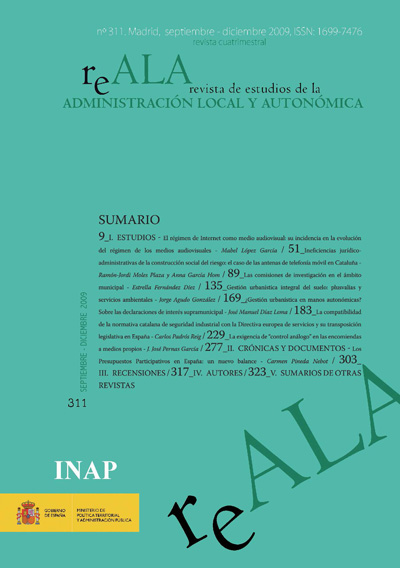Juridical and Administrative inefficiencies of the social construction of risk: the case of mobile phone masts in Catalonia
DOI:
https://doi.org/10.24965/reala.v0i311.9686Keywords:
Risk governance, mobile phone infrastructure, juridical inefficiency, regulatorAbstract
The deployment of mobile telephone infrastructures in Catalonia constitutes a key factor for the development of the information society and a cause of public controversy as a consequence of the collective perception of a socially constructed risk in relation to the effects on human health of electromagnetic radiation. This controversy has caused the stagnation of the deployment of infrastructures even when it is supported by a legal framework that were initially designed to regulate and promote said deployment by fostering cooperation between the different stakeholders. Administrative regulations that were originally passed to promote technological infrastructure become an obstacle to the same on the basis of the conflicts generated by the stakeholders in the process, especially Local Administration and mobile telephone operators. The consequences of this stagnation leads to what is known as the digital divide, i.e. the division between citizens and companies that reside in regions where there is sufficient coverage and those that cannot access it. This phenomenon is even more pronounced when it comes to the implantation of third generation mobile telephony, which requires the installation of a larger number of antennas. In this context, it is highly recommendable for proposals to be formulated for efficient local administrative- uridical praxis.Downloads
References
Althaus, C. E. (2005), “A disciplinary perspective on the epistemological status of risk”, Risk Analysis, 25(3): 567-588.
Berger, P.y Luckmann, T. (1996) [1966], La construcció social de la realitat. Barcelona: Herder.
Beck, U. (1992) [1986], Risk society: Towards a new modernity. Londres: Sage.
Beck, U. (2000), “Foreword” en S. Allan y C. Carter, eds., Environmental risks and the media. Londres: Routledge: xii-xiv.
Burgess, A. (2004), Cellular phones, public fears and a culture of precaution. Cambridge: Cambridge University Press.
Chinchilla Marin C. (2007), “Despliegue de infraestructuras de telecomunicaciones y su régimen jurídico. Las licencias y autorizaciones municipales para la instalación de redes de comunicaciones electrónicas”, Universidad Internacional Menéndez Pelayo, Santander.
Cotino Hueso L. (2005), “Las conflictivas ordenanzas municipales sobre instalación y funcionamiento de equipos de telecomunicaciones, en particular antenas de telefonía móvil”, Revista Aranzadi de Derecho y Nuevas Tecnologias, 9: 49-64.
De la Torre Martinez, L. (2006), La intervención de los municipios en las telecomunicaciones. Valencia: Tirant lo Blanch.
Eder, K. (1996), The social construction of nature. Londres: Sage.
Fitzpatrick, T. (2003), “Introduction: New technologies and social policy”, Critical Social Policy, 23 (2): 131-138.
Garcia, A. (2005), Negociar el riesgo. Barcelona: Ariel.
García de Enterría, E. y De la Quadra-Salcedo, T. coord. (2004), Comentarios a la Ley General de Telecomunicaciones. Ley 32/2003, de 3 de noviembre. Madrid: Civitas Ediciones.
Garvin, T. (2001), “Analytic paradigms: The epistemological distances between scientists, policy-makers, and the public”, Risk Analysis, 21 (3): 443-455.
Giddens, 1991: citado en Burgess (2004), Cellular phones, public fears and a culture of precaution. Cambridge: Cambridge University Press.
Habermas, J. (1989) [1962], The structural transformation of the public sphere: An inquiry into a category of bourgeous society. Cambridge: MIT Press.
Hardell, L. et al. (1999), “Cellular telephones and the risk for brain tumors: A case-control study”, International Journal of Oncology, 15(1): 113-6.
Kheifets, L. I. et al. (2000), “The precautionary principle and EMF: Implementation and evaluation”, Journal of Risk Research, 4 (2): 113-125.
Lobo Rodrigo, A. (2007), “La planificación territorial y urbanística de las antenas de telefonía móvil de tercera generación” Revista de Derecho de las Telecomunicaciones e Infraestructuras en Red, 29: 11-36.
Lupton, D. (1999), Risk. Londres: Routledge.
Macgregor, D. et al. (1994), “Perception of risks from electromagnetic fields: A psychometric evaluation of a risk-Communication approach”, Risk Analysis, 14 (5): 815-28.
Mcdaniels, T. y Small, M. eds. (2003), Risk analysis and society: An interdisciplinary characterization of the field. Londres: Cambridge University Press.
Mcguigan, J. (2005), “Towards a sociology of the mobile phone”, Human Technology, 1 (1): 45-57.
Mercer, D. (2002), “Scientific method discourses in the construction of ‘EMF Science’: Interests, resources and rethoric in submissions to a public inquiry”, Social Studies of Science, 32 (2): 205-33.
Mitchell, L. M. y Cambrosio, A. (1997), “The invisible topography of power”, Social Studies of Science, 27 (2): 221-271.
Molina Jimenez, A. (2002), Las antenas de telefonía móvil. Régimen Jurídico. Análisis de los impactos visuales y radioléctricos en las comunicaciones móviles. Pamplona: Aranzadi.
Montoro Chiner M.J. (2001), “Objetivos, naturaleza y límites de la declaración de impacto ambiental de las infraestructuras públicas”, Revista Española de Derecho Administrativo, Madrid, 110: 173-202.
Moulder, J. E. y Foster, K. R. (2005), “Mobile Phones, mobile phone base stations and cancer”, International Journal of Radiation Biology, 81 (3): 189-203.
Ramirez Cascales, M.C. (2002), “El papel de los municipios para la autorización de antenas de telefonía móvil”, Actualidad administrativa, 16: 405-424.
Renn, O. (1992), “Concepts of Risk” en S. Krimsky y D.Golding. eds., Social Theories of Risk. Praeger Paperback.
Santamaría Pastor, J.A. (1988), Fundamentos de Derecho Administrativo. Tomo I del Centro de Estudios Ramon Areces, Madrid: Fundación Ramón Areces.
Stilgoe, J. (2005): “Controlling mobile phone health risks in the UK: A fragile dicourse of compliance”. Science and Public Policy, 32 (1): 55-64.
(2007), “The (co-)production of public uncertainty: UK scientific advice on mobile phone risks”. Public Understanding of Science, 16 (1): 45.61.
Strydom, P. (2002), Risk, environment and society. Buckingham: Open University Press.
Taylor-Gooby, P. (2002), “Editorial: Varieties of risk”. Health, Risk & Society, 4 (2): 109-111.
Tejerizo López, J. M. (2001), La tributación local de los operadors de telecomunicaciones. Barcelona: Localret.












